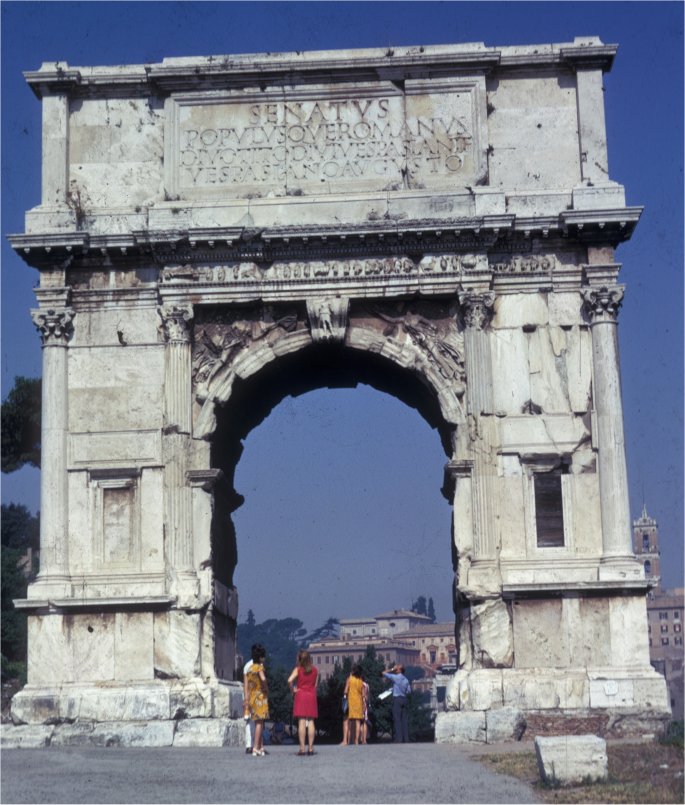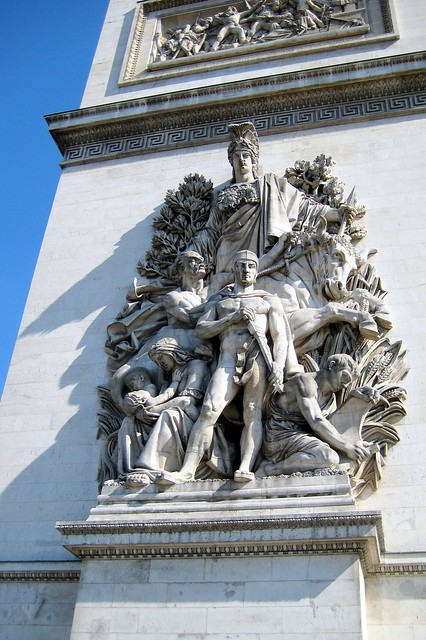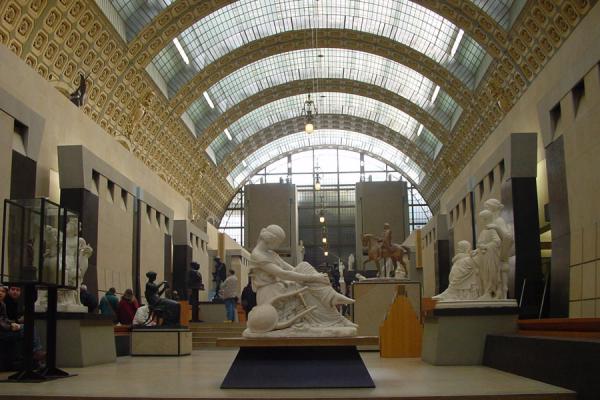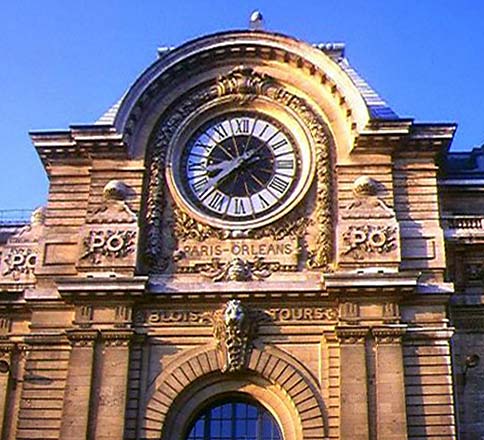Tuesday, February 28, 2012
Sacré-Cœur: The Sacred Heart
As a result of the outbreak of the Franco-Prussian war in 1870, the founders of the Church of the Sacred Heart of Christ -- Alexandre Legentil and Rohault de Fleury -- were driven to erect an immense basilica for worship, and construction began in 1875. The architects were inspired by the Romano-Byzantine style of St-Front in Périgueux. The church was completed in 1914, but it was not consecrated until 1919 after France was victorious over the German invasion.
Inside is the Great Mosaic of Christ, which follows the domed curvature of the ceiling above the altar and is distorted to realistic proportions as viewed by the congregation. The bell tower of the church of Sacré-Cœur stands 252 feet tall, and is the second-tallest building in Paris after the Eiffel Tower. Many statues and decorations adorn the building, and it can be seen that this building differs from the Gothic style of Notre Dame because the arches are rounded and the ceiling style is domed rather than vaulted.
Arc de Triomphe de l'Étoile
There is a smaller, "sister" verison of the Arc de Triomphe just outside of the Louvre named the Arc de Triomphe du Carrousel.
It was designed by Jean Chalgrin in 1806 and inaugurated on July 29th, 1836. Its design was inspired by the Roman Arch of Titus.
The four major sculptures of the arch are:
Le Depart de 1792
Le Triomphe de 1810
La Resistance de 1814
La Paix de 1815
There are also six reliefs (raised carvings) sculpted on the Arch, depicting important moments of the Revolution and Napoleonic Era.
The Arc de Triomphe honors those who fought for France in the French Revolutionary and Napoleonic Wars. The Arch has all of the names of the French victories and generals on the inner and outer surfaces.
Beneath the Arch is The Tomb of the Unknown Soldier of World War I. A ceremony is held at the arch every year on November 11 to honor the armistice signed between France and Germany in 1918.
Sources: http://www.wikipedia.org
La Tour Eiffel (The Eiffel Tower)
+057.JPG) |
| View of the Tower from the Trocadéro |
+005.JPG) |
| View into the Tower from the Ground |
+006.JPG) |
| View of the Lattice Structure |
+012.JPG) |
| View of one of the Legs from inside the Tower |
+015.JPG) |
| View Down into the Eiffel Tower |
+028.JPG) |
| View of the top from the Second Floor |
+022.JPG) |
| Trocadéro |
The Eiffel Tower, nicknamed "La Dame de Fer", is the tallest tower in Paris, and it is one of the most recognizable buildings in the world and is the most visited paid monument in the world. Built in 1889 for the World Fair, it is an ingenious example of engineering. The tower is 324 meters tall (1,063 feet), equivalent to 81 stories tall, with 600 steps up to the second floor from the ground (300 from the ground to the first, and then 300 from the first to the second). It held the title of the tallest man-made structure in the world for 41 years until the Chrysler building was built in New York City (1930). It took two years to build (1887-1889) and was opened March 31, 1889. There are three floors that are available to be accessed by visitors, but the third floor is only accessible by elevator. We climbed all 600 stairs to the second floor, but we could not reach the third floor because the elevator was under maintenance. The tower is made out of pig iron, made from smelting iron ore, in a lattice structure formation making it very stable; research shows that the tower sways a maximum of two to three inches in the heaviest of winds. It is painted three different shades of the same color to give it the proper perspective; the cost to repaint the tower every seven years is $5,300,000. The electric bill every year is $400,000 (7.5 million kilowatt-hours). The scrap value of the tower is $3,500,000, while the land is worth $350,000,000 (according to the show "Pricing the Priceless". The tower has become the most prominent symbol of Paris and France.
Le Panthéon
Musee d'Orsay
Musee d'Orsay was previously a train station called Gare d'Orsay. It was contructed by Chemin de Fer de Paris a Orleans and designed by Lucien Magne, Emile Benard, and Victor Laloux around 1900. However, after 1939, the low platforms were unfitting for the new trains. For a brief period, the d'Orsay was used for movies. When a plan to demolish the station and build a new hotel came in, the minister of cultural affairs, Jacques Duhamel, ruled against it. Instead, the d'Orsay was turned into a museum as suggested by the the directorate of museums of France. To design the new museum, a competition was held in 1978. Now, it is a museum which houses arts from around the impressionist period (1848-1915) along with post impressionist arts which bridges the gap between the Louvre and Centre Pompidou. It is divided into three floors with art on both sides. You can still see signs of it previously being a train station. A large, functional clock still remains from when the d'Orsay was a station.
Source: http://en.wikipedia.org/wiki/Mus%C3%A9e_d%27Orsay
http://www.musee-orsay.fr/en/collections/history-of-the-collections/architecture.html
http://www.destination360.com/europe/france/images/s/musee-d-orsay.jpg
http://www.traveladventures.org/continents/europe/images/orsay06.jpg
http://www.discoverfrance.net/France/Images/Paris/Museums/Orsay/Orsay_outdoor_clock-lg.jpg
Musee d'Orsay
Inside the Orsay
Clock from outside the Orsay
Source: http://en.wikipedia.org/wiki/Mus%C3%A9e_d%27Orsay
http://www.musee-orsay.fr/en/collections/history-of-the-collections/architecture.html
http://www.destination360.com/europe/france/images/s/musee-d-orsay.jpg
http://www.traveladventures.org/continents/europe/images/orsay06.jpg
http://www.discoverfrance.net/France/Images/Paris/Museums/Orsay/Orsay_outdoor_clock-lg.jpg
Place de la Concorde
On Saturday, we visited the huge Place de la Concorde to see the obelisk in its center and to soak up some of its lurid history. The Place de la Concorde is the largest square in Paris, located in the eighth arrondissement. It is fixed at the eastern end of the famous Champs-Elysees. The square was designed by Ange-Jacques Gabriel in 1755, and named Place Louis XV to honor the king. In the center of the square stood a statue of the king. During the French Revolution, the statue was torn down and the square was renamed "Place de la Révolution." The new revolutionary government then erected a guillotine in the square, and guillotined King Louis XVI, Marie Antoinette, Georges Danton, Antoine Lavoisier, Maximilien Robespierre, and many other famous French people who opposed the revolution, or were perceived as working for the old royal government. The square's guillotine was most active during the "Reign of Terror" of 1794, when in a single month more than 1300 people were executed. A year later, the guillotine was removed, and the square renamed Place de la Concorde as a symbolic gesture of reconciliation after the chaotic French Revolution.
In the center of the Place de la Concorde stands the Luxor Obelisk, a huge Egyptian obelisk covered with hieroglyphics exalting the pharaoh Ramses II. The Egyptian government gave two to the French in the 1800s. The obelisk arrived in Paris on December 21, 1833. In 1836, King Louis Philippe placed it in the center of the Place de la Concorde, in place of the guillotine. The obelisk is made of red granite, is 75 feet tall, and weights over 280 tons.
Hieroglyphs
Saturday, February 25, 2012
Notre Dame
Yesterday, we saw Notre Dame and descended underneath to tour the 4th century ruins of buildings and streets below the level of the city (see the picture at the bottom). It was interesting to read about the heating system installed under the floor, even so long ago.
The cathedral itself was built between 1160 and 1345, and the Gothic style allowed for large stained-glass windows to be installed. Since windows cannot support the weight of the roof, there must be thick columns inside and a vaulted ceiling, along with supports on the outside of the building, called flying buttresses, that prevent the walls from falling outward under the weight of the roof. These flying buttresses are visible on the back of the cathedral, and resemble arches that descend from the walls.
The Gothic style contrasts with the earlier Romanesque architecture because the arches are pointed and because of the presence of large stained-glass windows. The largest of these windows is round, and it is visible in the picture below. Romanesque architecture does not implement sophisticated methods of support, such as flying buttresses, so a Romanesque building of an earlier time would be very dark inside because of the tiny windows, and would have semi-circular arches instead of pointed ones.
The cathedral itself was built between 1160 and 1345, and the Gothic style allowed for large stained-glass windows to be installed. Since windows cannot support the weight of the roof, there must be thick columns inside and a vaulted ceiling, along with supports on the outside of the building, called flying buttresses, that prevent the walls from falling outward under the weight of the roof. These flying buttresses are visible on the back of the cathedral, and resemble arches that descend from the walls.
The Gothic style contrasts with the earlier Romanesque architecture because the arches are pointed and because of the presence of large stained-glass windows. The largest of these windows is round, and it is visible in the picture below. Romanesque architecture does not implement sophisticated methods of support, such as flying buttresses, so a Romanesque building of an earlier time would be very dark inside because of the tiny windows, and would have semi-circular arches instead of pointed ones.
Wednesday, February 22, 2012
Subscribe to:
Posts (Atom)


+066.JPG)
+080.JPG)
+042.JPG)






+047.JPG)





.JPG)






